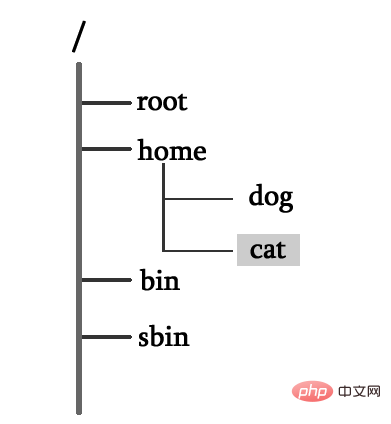 Operation and Maintenance
Operation and Maintenance
 Linux Operation and Maintenance
Linux Operation and Maintenance
 What does '.' mean in linux file path
What does '.' mean in linux file path
What does '.' mean in linux file path
In Linux, the "." in the file path means "current directory". If the directory name starts with ".", it means that the directory is hidden; for example, "./file name" means the current directory. There is a specified file in the directory, ".." indicates the directory above the current directory.

#The operating environment of this tutorial: linux7.3 system, Dell G3 computer.
What does "." mean in the Linux file path
.Represents the current directory
./crack.py indicates that there is a crack in the current directory .py file (.py is the file suffix)..Represents the upper-level directory of the current directory../start means that there is a start file (or directory) in the current directory. It can also mean running a program and close it with ctrl c.
Extended knowledge: absolute paths and relative paths in Linux
In the Linux system, files are stored in directories, and directories can Stored in other directories, therefore, the user (or program) can use the file name and directory name to search and locate the desired directory or file starting from anywhere in the file tree.
There are two ways to specify the location of a directory or file name, using absolute paths and relative paths respectively. The absolute path refers to the file or directory name written starting from the root directory (/), while the relative path refers to the writing relative to the current path.
In other words, the absolute path must start with a forward slash (/), which is the root directory, and go to the name of each directory that must be passed to find the object (directory or file), which is the file location Complete waypoints, so in any case the required file can be found using the absolute path. For example:
[root@localhost ~]# cd /usr/local/src [root@localhost src]# cd /etc/rc.d/init.d
These methods of switching directories use absolute paths.
cd is a command to switch directories. The specific usage of this command will be introduced in detail in subsequent chapters.
The relative path does not start with a forward slash. It starts from the current directory and ends with the name of each directory that must be passed to find the object (directory or file). For example:
[root@localhost /]# cd etc #当前所在路径是/目录,而/目录下有etc目录,所以可以切换 [root@localhost etc]# cd etc -bash:cd:etc/:没有那个文件或目录 #而同样的命令,由于当前所在目录改变了,所以就算是同一个命令也会报错,除非在/etc/目录中还有一个etc目录
Normally, relative paths are shorter than absolute paths, which is why many users like to use relative paths.
The example is as follows:

Assume that the user's current directory is cat, and he wants to switch to the dog directory at this time. In this case, the switching path has the following two expressions:
Use an absolute path, written as: /home/dog, which means that the directory to be switched is the dog directory in the home directory under the root directory;
You can also use a relative path, written as: ../dog, where .. represents the parent directory of the current directory (home directory), that is, relative to the current directory cat, you need to switch to the parent directory. The dog directory under home.
Recommended learning: Linux video tutorial
The above is the detailed content of What does '.' mean in linux file path. For more information, please follow other related articles on the PHP Chinese website!

Hot AI Tools

Undresser.AI Undress
AI-powered app for creating realistic nude photos

AI Clothes Remover
Online AI tool for removing clothes from photos.

Undress AI Tool
Undress images for free

Clothoff.io
AI clothes remover

AI Hentai Generator
Generate AI Hentai for free.

Hot Article

Hot Tools

Notepad++7.3.1
Easy-to-use and free code editor

SublimeText3 Chinese version
Chinese version, very easy to use

Zend Studio 13.0.1
Powerful PHP integrated development environment

Dreamweaver CS6
Visual web development tools

SublimeText3 Mac version
God-level code editing software (SublimeText3)

Hot Topics
 1377
1377
 52
52
 Unable to log in to mysql as root
Apr 08, 2025 pm 04:54 PM
Unable to log in to mysql as root
Apr 08, 2025 pm 04:54 PM
The main reasons why you cannot log in to MySQL as root are permission problems, configuration file errors, password inconsistent, socket file problems, or firewall interception. The solution includes: check whether the bind-address parameter in the configuration file is configured correctly. Check whether the root user permissions have been modified or deleted and reset. Verify that the password is accurate, including case and special characters. Check socket file permission settings and paths. Check that the firewall blocks connections to the MySQL server.
 C language conditional compilation: a detailed guide for beginners to practical applications
Apr 04, 2025 am 10:48 AM
C language conditional compilation: a detailed guide for beginners to practical applications
Apr 04, 2025 am 10:48 AM
C language conditional compilation is a mechanism for selectively compiling code blocks based on compile-time conditions. The introductory methods include: using #if and #else directives to select code blocks based on conditions. Commonly used conditional expressions include STDC, _WIN32 and linux. Practical case: Print different messages according to the operating system. Use different data types according to the number of digits of the system. Different header files are supported according to the compiler. Conditional compilation enhances the portability and flexibility of the code, making it adaptable to compiler, operating system, and CPU architecture changes.
 What are the 5 basic components of Linux?
Apr 06, 2025 am 12:05 AM
What are the 5 basic components of Linux?
Apr 06, 2025 am 12:05 AM
The five basic components of Linux are: 1. The kernel, managing hardware resources; 2. The system library, providing functions and services; 3. Shell, the interface for users to interact with the system; 4. The file system, storing and organizing data; 5. Applications, using system resources to implement functions.
 Solutions to the errors reported by MySQL on a specific system version
Apr 08, 2025 am 11:54 AM
Solutions to the errors reported by MySQL on a specific system version
Apr 08, 2025 am 11:54 AM
The solution to MySQL installation error is: 1. Carefully check the system environment to ensure that the MySQL dependency library requirements are met. Different operating systems and version requirements are different; 2. Carefully read the error message and take corresponding measures according to prompts (such as missing library files or insufficient permissions), such as installing dependencies or using sudo commands; 3. If necessary, try to install the source code and carefully check the compilation log, but this requires a certain amount of Linux knowledge and experience. The key to ultimately solving the problem is to carefully check the system environment and error information, and refer to the official documents.
 How to solve mysql cannot be started
Apr 08, 2025 pm 02:21 PM
How to solve mysql cannot be started
Apr 08, 2025 pm 02:21 PM
There are many reasons why MySQL startup fails, and it can be diagnosed by checking the error log. Common causes include port conflicts (check port occupancy and modify configuration), permission issues (check service running user permissions), configuration file errors (check parameter settings), data directory corruption (restore data or rebuild table space), InnoDB table space issues (check ibdata1 files), plug-in loading failure (check error log). When solving problems, you should analyze them based on the error log, find the root cause of the problem, and develop the habit of backing up data regularly to prevent and solve problems.
 Can mysql run on android
Apr 08, 2025 pm 05:03 PM
Can mysql run on android
Apr 08, 2025 pm 05:03 PM
MySQL cannot run directly on Android, but it can be implemented indirectly by using the following methods: using the lightweight database SQLite, which is built on the Android system, does not require a separate server, and has a small resource usage, which is very suitable for mobile device applications. Remotely connect to the MySQL server and connect to the MySQL database on the remote server through the network for data reading and writing, but there are disadvantages such as strong network dependencies, security issues and server costs.
 MySQL can't be installed after downloading
Apr 08, 2025 am 11:24 AM
MySQL can't be installed after downloading
Apr 08, 2025 am 11:24 AM
The main reasons for MySQL installation failure are: 1. Permission issues, you need to run as an administrator or use the sudo command; 2. Dependencies are missing, and you need to install relevant development packages; 3. Port conflicts, you need to close the program that occupies port 3306 or modify the configuration file; 4. The installation package is corrupt, you need to download and verify the integrity; 5. The environment variable is incorrectly configured, and the environment variables must be correctly configured according to the operating system. Solve these problems and carefully check each step to successfully install MySQL.
 Unable to access mysql from terminal
Apr 08, 2025 pm 04:57 PM
Unable to access mysql from terminal
Apr 08, 2025 pm 04:57 PM
Unable to access MySQL from the terminal may be due to: MySQL service not running; connection command error; insufficient permissions; firewall blocks connection; MySQL configuration file error.



